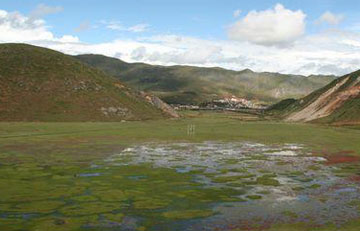Destruction of wetlands worsens global warming
Destruction of wetlands worsens global warming
mongabay.com
July 20, 2008
|
|
Destruction of wetland ecosystems will generate massive greenhouse gas emissions in coming years, warn experts convening at an international wetlands conference in Brazil.
While they cover only 6 percent of the world’s surface, wetlands — marshes, peat bogs, swamps, river deltas, mangroves, tundra, lagoons and river floodplains — are estimated to hold 771 gigatons of greenhouse gases , or 10-20 percent of the globe’s terrestrial carbon. Beyond carbon storage, wetlands provide a range of environmental services, including water filtration and storage, erosion control, a buffer against flooding, nutrient recycling, biodiversity maintenance, and a nursery for fisheries. But drainage and destruction of these ecosystems is responsible for large amounts of carbon emissions (40 tons of carbon per hectare per year for drained tropical swamp forests) as well as degradation of the other services they provide.
 A recent study estimated the economic value of flood prevention and other ecological services provided by wetlands at $15,000 per hectare per year, a sum greater than any other ecosystem — seven times that of the next most valuable, tropical rainforests. |
“Too often in the past, people have unwittingly considered wetlands to be problems in need of a solution,” said UN Under Secretary-General Konrad Osterwalder, a conference organizer. “Yet wetlands are essential to the planet’s health — and with hindsight, the problems in reality have turned out to be the draining of wetlands and other ‘solutions’ we humans devised.”
Some 60 percent of global wetlands have been destroyed in the past 100 years. 90 percent of Europe’s wetlands are gone, while 90 percent of Malaysia’s freshwater swamps have been drained for rice cultivation.
The conference, which expects some 700 experts from 28 nations, will look at ways to slow the destruction of wetlands as well as rehabilitation strategies. It will also investigate the role that wetlands play in maintaining environmental services.
 Wetlands contain an amount of carbon comparable to the carbon content of today’s atmosphere. This photo shows destruction of peatland in Kalimantan, Indonesia, on the island of Borneo, for oil palm cultivation. |
“This landmark conference beside the Pantanal will gather an overview of the status of global wetlands, identify knowledge gaps, create greater collaboration and consistency in wetland science worldwide, and offer a plain-spoken policy prescription for decision makers with an appeal to adopt it with urgency,” said Professsor Paulo Speller of Brazil’s Federal University of Mato Grasso which is hosting the meeting, the 8th INTECOL International Wetlands Conference meeting, held July 21-25 in the city of Cuiaba on the edge of South America’s Pantanal, the world’s largest tropical wetland.
News articles
10% of global CO2 emissions result from swamp destruction December 10, 2007
More than 10 percent of annual carbon dioxide emissions result from the degradation and destruction of peat swamps, reports the first comprehensive global assessment on the links between peatland degradation and climate change. The report, “Assessment on Peatlands, Biodiversity and Climate Change”, shows that clearance, drainage and fires in peatlands emit more than 3 billion tons of carbon dioxide every year, but that protection and restoration of peatlands are among the most cost-effective options for slowing global warming.
Peatlands store 100 years of CO2 emissions May 8, 2007
The UN Convention on Climate Change is putting global climate at risk by ignoring carbon dioxide emissions from the destruction of carbon-rich peatlands in Indonesia, charged Wetlands International, a Dutch environmental group that has highlighted the climate impact of land-use change in southeast Asia.